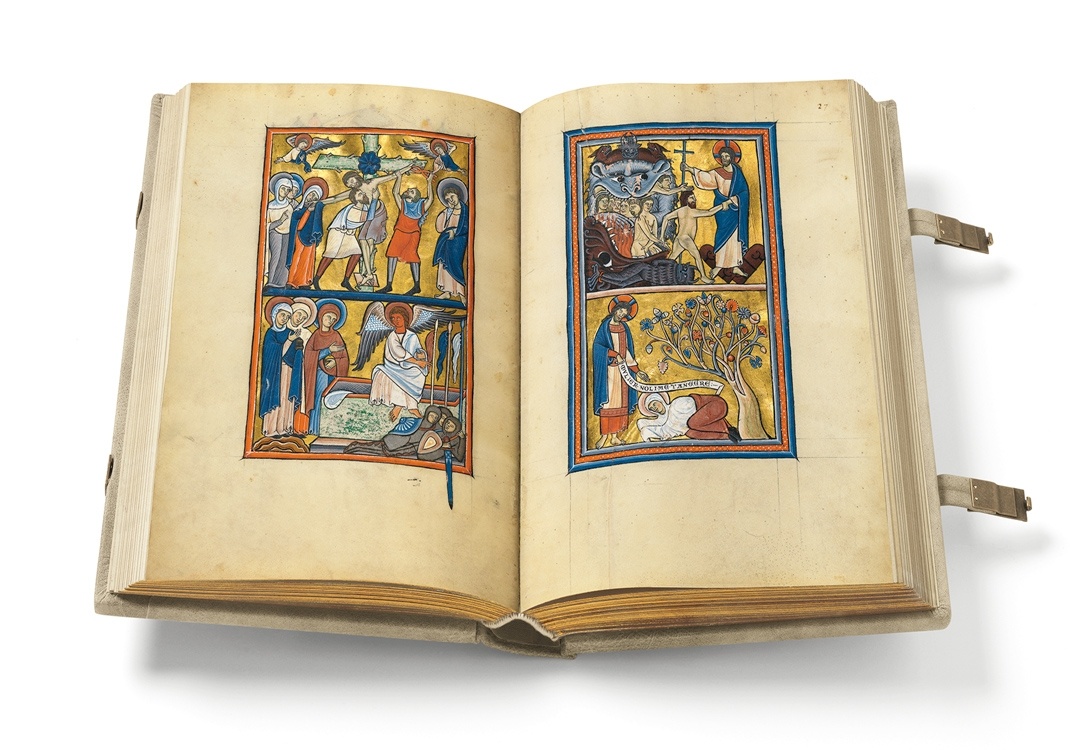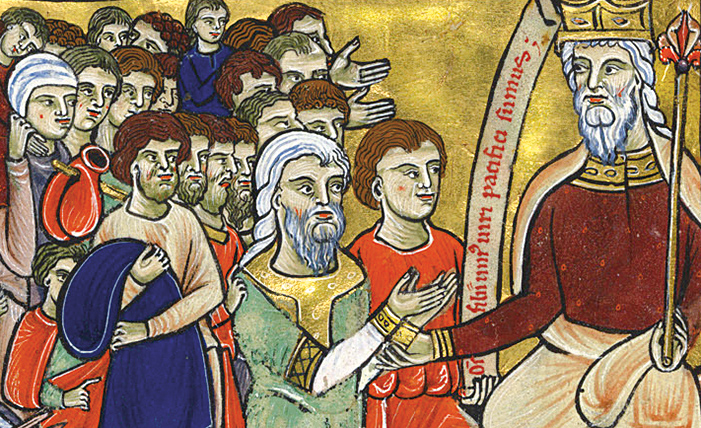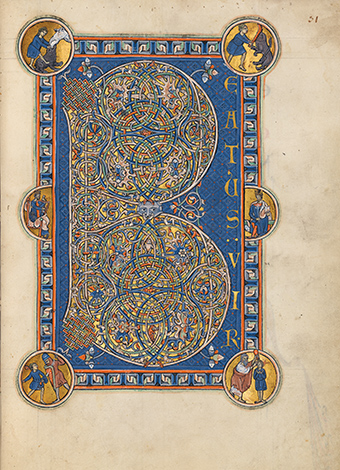The Munich Golden Psalter
The Richest Cycle of Miniatures from Medieval England
Be fascinated by the Munich Golden Psalter as it displays profusely ornamented initials and 91 pages full of miniatures set against gold backgrounds which illustrate events from the Old and the New Testament. Witness the colours and forms of the new artistic development under way in English book illumination at the end of the Romanesque period!
“The utmost care and highest standards applied to this edition will result in a magnificent work of art, commensurable with the sophisticated and unique original manuscript, which makes the timeless texts and the illumination of the Latin Psalters accessible to the public.” (Claudia Fabian, Head of the Department of Manuscripts and Old Prints, Bayerische Staatsbibliothek Munich)
Goldener Münchner Psalter
The Munich Golden Psalter: The Manuscript
Book Art in Transition
At the end of the Romanesque period artists were looking for new pictorial forms of expression. The style of book illumination began to deviate from the preceding traditions. Innovative features were tested in almost every miniature. The Munich Golden Psalter was created in this transitional style emerging around the year 1200. A departure from Romanesque pictorial formulae can best be observed in the figural representation. Although figures were not always rendered realistically, proportions were reduced, postures and gestures became more restrained, draperies were disposed in natural folds, and facial features were more carefully modelled.
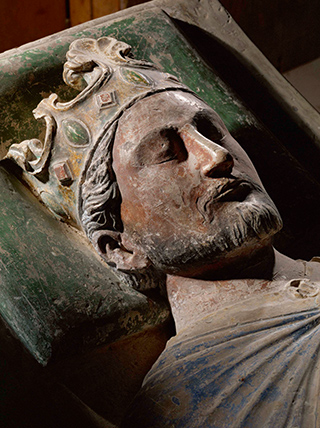
Tracking down the Patron
The Munich Golden Psalter was probably produced in Oxford about 1200. Indications as to the patron of the manuscript are provided by certain saints included in the calendar. They suggest a connection with the Benedictine Saint Guthlac’s Priory in Hereford, belonging to Gloucester Abbey. Saint Guthlac’s had been founded in the late 11th century on the initiative of the de Lacy family. Around 1200 the head of this noble house was Walter II de Lacy who, acting as justiciar and supporter of the English kings, was in favour with Richard the Lionheart and his brother, John Lackland. The precious Psalter might have been a gift on the occasion of Walter de Lacy’s marriage with Margaret de Briouze in 1200 or 1201.
Unusual Pictorial Cycles
In the Munich Golden Psalter the unusually elaborate pictorial cycles with scenes from the Old and the New Testament are interrelated and evenly distributed among the text pages adorned with initials. Following on after the calendar, the first sequence of 27 miniatures represents scenes from Genesis up to the Fall of Jericho. The first cycle with subjects from the New Testament depicts scenes from the life of Christ. Psalm 51 is followed by another sequence of subjects from the New Testament. After a sequence of several more Psalms, illustrations of various books of the Old Testament and scenes from the life of David are inserted. Five miniatures complete the last cycle. They illustrate the psalms of praise to the Lord, and also include an author portrait of King David, as well as further scenes from his life.
Goldener Münchner Psalter
Under the Magnifying Glass: A Great Variety of Splendid Golden Initials
Intended as more than mere decoration, the decorated initials in the Munich Golden Psalter structure and organize the text. Thus the first Psalm opens with a lavishly decorated full-page golden initial. In addition, there are ten almost half-page decorated initials composed of elegantly interwoven coloured or golden bands, sometimes featuring elongated dragon bodies and foliate sprays. The Psalms and other prayer texts are opened by some 180 multiline initials, some of which are historiated and others ornamented. There were virtually no limits to the book illuminator’s creativity. All manner of creatures inhabit the ornamented initials. The viewer can even discover early examples of drolleries and first attempts at fleuronné pen work.
On fol. 31r a magnificent full-page initial marks the opening of Psalm 1 (‘Beatus vir’). The two parts of the letter B are clasped in the centre by a mask-like face. Set against a luminous gold ground, blue, green, red and brown bands are interlaced in spirals ending in dragon’s heads and foliate forms. The patterns of the initial are inhabited by numerous small white lions, as well as a crouching grotesque hybrid and another hybrid creature playing a viola. A meandering band creating a spatial effect frames the patterned blue background which provides a perfect foil for the first words of the Psalm. The surrounding medallions show scenes from the life of King David.
Goldener Münchner Psalter
The Munich Golden Psalter: The Edition
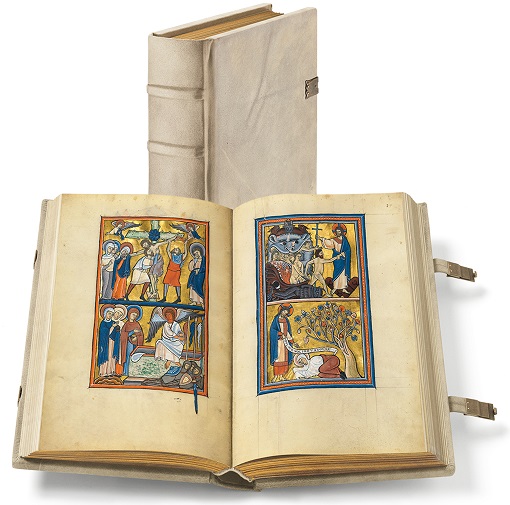
The Manuscript and the Facsimile at a Glance
The Munich Golden Psalter stands out for its exceptionally lavish illumination which is outstanding even when compared with other richly illuminated psalters. The facsimile edition replicates this wealth of illumination down to the smallest detail, resplendent with sparkling gold, shimmering silver and brilliant colours.
Manuscript: Munich, Bayerische Staatsbibliothek, Clm 835
Date of Origin: c. 1200/10
Place of Origin: Oxford (?)
Dimensions: c. 28.0 x 19.5 cm
Extent: 338 pages (169 leaves)
Artists: supposedly three masters in an Oxford workshop
Patron: possibly Walter II de Lacy, an Anglo-Norman nobleman, and /or his spouse Margaret de Briouze
Illumination: 91 full pages of miniatures on a sparkling gold ground, containing 236 scenes; one full-page and ten half-page initials, some 180 multiline initials, partly historiated, partly ornamented; coloured and golden line ornaments; 24 calendar medallions
Binding: pale suede leather binding with two brass clasps
Commentary Volume for the Facsimile Edition by Nigel J. Morgan / Carolin Schreiber
Print run: 680 copies
Goldener Münchner Psalter
Enjoy Viewing 10 Sample Pages:
A Glance at the Facsimile
The section here selected from the Munich Golden Psalter comprises the sequence of fols. 64v–69r.
It starts with Psalm 51 and the lavishly decorated twelve-line initial Q. Its tail is shaped like a dragon into whose mouth a man thrusts a spear. The Psalm is followed by a pictorial cycle with full-page miniatures set against a gold ground, illustrating scenes from the New Testament. They depict events from Christ’s public life, among them a number of miraculous healings and parables.
All miniatures have wide decorated frames, each with a different design.
Goldener Münchner Psalter
A Challenging Production: fac simile
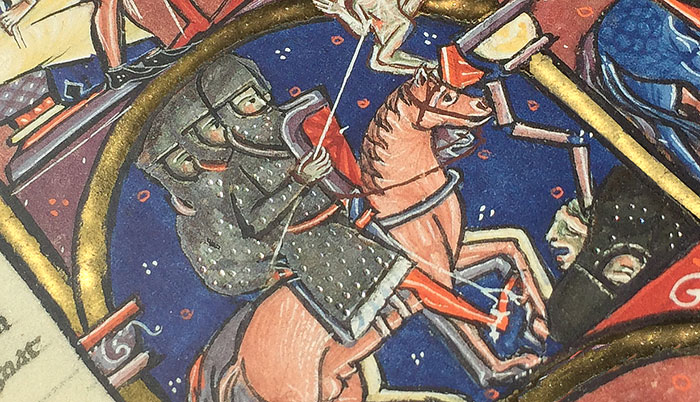
Gold and Silver
It is especially challenging to reproduce a manuscript that is as lavishly illuminated with gold and silver as the Munich Golden Psalter. The appearance of the gold areas and the various shades of the tarnished silver have to match the original manuscript. Therefore, the gold and the silver areas have to be captured separately in digital photographs and then processed by the lithographer with the utmost care and meticulousness. In separate print runs the printing machine subsequently applies different kinds of gold and silver, but only the patination brings out the lively appearance of the metal surfaces as seen in the original.
Specialists at Work
Every step in producing the facsimile of the Munich Golden Psalter requires the skill of specialists to obtain a faithful replica of the original. After photographs of the manuscript have been taken on site, it falls to the lithographer to process the digital imaging data at the computer and prepare the images for the print run. Subsequently, each page is compared with the original to detect and correct even the smallest colour deviations. The book binder folds the completed printing sheets in sections and sews them to form the book-block. The book-block is then attached to the leather cover and placed in the press. The raised bands on the spine are emphasized by having the leather nipped up around them.
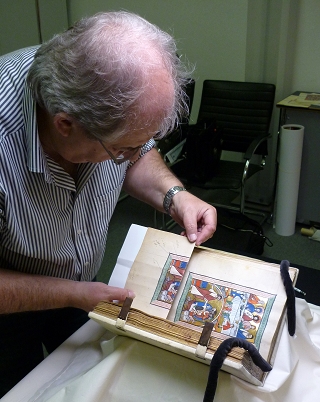

Goldener Münchner Psalter
The Facsimile Folder for the Edition
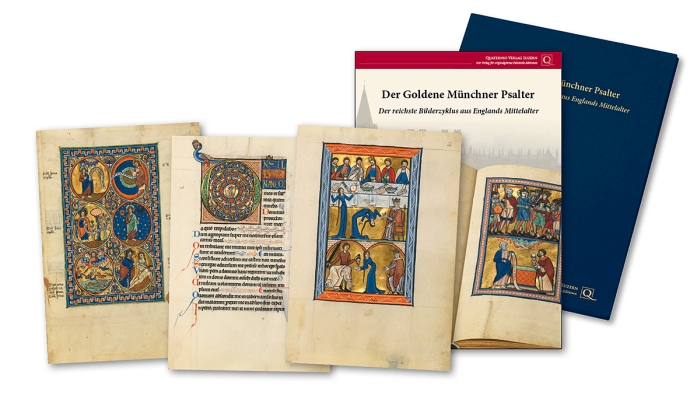
The facsimile folder for the Munich Golden Psalter contains three original facsimile leaves (fols. 8, 46 and 66). Their front pages (recto) show the Creation, the decorated initial D opening Psalm 26, and Salome’s dance, together with the beheading of John the Baptist. The reverse pages (versos) are likewise richly illustrated. They depict the Expulsion from Paradise, a text with a historiated initial and the Feeding of the Multitude. Detailed captions explain the wealth of these images. In a richly illustrated16-page brochure, learn more about the art and the history of this fascinating transition from the Romanesque to the Gothic period.
Goldener Münchner Psalter
Order facsimile folder
Click here to go to the online shop (German only) where you can order the facsimile folder for the Munich Golden Psalter edition. Or send us an email to info@quaternio.ch.
Request brochure
We would be glad to provide you with additional information regarding the fine art facsimile edition of the Munich Golden Psalter. Click here to order the brochure.




